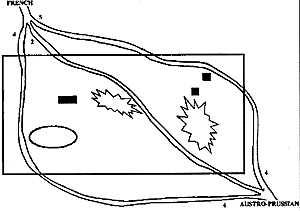 While designing a Napoleonic miniatures battle recently, one of the players began to complain about the lack of “strategy” in miniatures contests. While it seemed he was belaboring an obvious point, I nevertheless undertook the task of introducing some kind of beyond the table maneuver. Re-reading old battle reports, I was struck by the phony settings which report writers try to work into their actions after they are fought (such and such marched down this road on a special assignment, and, alerted by partisans of that went there, etc.). So I tried to devise a new system, something that would allow the player to make some decisions BEFORE they marched on the field, yet remaining short of a campaign-style affair with attendant confusion and maps and referees. My solution is the ‘road approach system”.
While designing a Napoleonic miniatures battle recently, one of the players began to complain about the lack of “strategy” in miniatures contests. While it seemed he was belaboring an obvious point, I nevertheless undertook the task of introducing some kind of beyond the table maneuver. Re-reading old battle reports, I was struck by the phony settings which report writers try to work into their actions after they are fought (such and such marched down this road on a special assignment, and, alerted by partisans of that went there, etc.). So I tried to devise a new system, something that would allow the player to make some decisions BEFORE they marched on the field, yet remaining short of a campaign-style affair with attendant confusion and maps and referees. My solution is the ‘road approach system”.
By this method, the designer first plans his battlefield terrain, objectives, and OBs or point thresholds. He then lays out a system of roads leading to various points along the table’s edge and tries to connect them in some logical way on the field. My first road network is shown in the illustration, below. The numbers next to each road refer to how many FRAPPE bounds (an early wargames rule set read “game turns” - ED) it takes a unit to move from the road junction at the rear to the table’s edge. In this particular game, French and Austro-Prussian forces arrived at the junctions according to a predetermined schedule. As they arrived, the respective commanders committed their units to march down one of the various roads.
This list of committals essentially became an order of appearance chart. ‘When the units arrived at the field’s edge, a unit was given three options;
- (1) to move on in Column of March,
(2) to wait one bound and enter deployed, or
(3) simply wait off the table.
Of course, option (3) holds up everything else using that road as well. Finally, some rules were introduced to allow an unopposed unit to march right up to the enemy baseline and “watch” the particular road to which he was adjacent. The enemy commander had to first tell him if anything was being held there, and also provide a one bound warning of an approaching column. Thus it became vital for a commander to keep his roads from enemy surveillance.
This system has far more potential than I’ve used it for here. You can use this technique to mask your disposition from an opponent, simply by holding back your assault wing. All too often, each side forms mirror images of the other in a typical deploy and fight action. Now you can introduce uncertainty into an enemy’s mind by feinting with your weak wing and engaging his reserves (hopefully) and pinning him down. And when the time is ripe, you can then send your 6000 Cuirassiers off at that Landwehr holding the ‘quiet sector’.
Other improvements in the system might include varying the road types; allowing units to quicken their pace (with resultant fatigue); perhaps one could introduce Mr. Jones’ variable speed concept (an earlier article by Bob Jones - of Piquet fame- suggesting diceing for moving through rough terrain and over roads at a rate unknow to the marcher until he actually makes the move - ED) with unknown dangers lurking on roads which have not been properly scouted. Finally, the system has an advantage in simulating converging-column battles, wherein two allied forces approach a common foe by different routes. As the separate commands began to struggle off down the various roads, they would have no knowledge of the other’s actions.
This is quite similar to Frederick the Great’s situation at Torgau, when he marched quickly into action while his subordinate, Ziethen, held his army back, choosing to merely skirmish with some Austrian light troops. All this met with nearly tragic results. So give this simple suggestion a try - you might find it can add quite a lot to your miniatures battle.
More of the Best of the Old Courier
Back to Table of Contents -- Courier #80
To Courier List of Issues
To MagWeb Master Magazine List
© Copyright 2000 by The Courier Publishing Company.
This article appears in MagWeb (Magazine Web) on the Internet World Wide Web.
Other military history articles and gaming articles are available at http://www.magweb.com